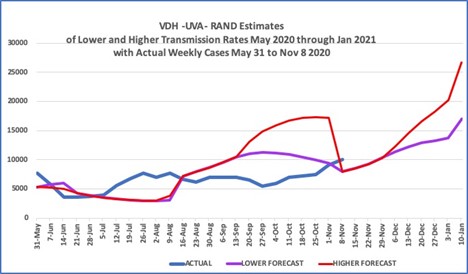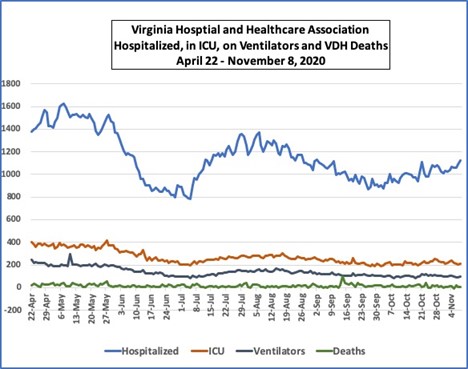Since mid-April, 2020, the Virginia Department of Health (VDH) has reported weekly on information from the University of Virginia (UVA) Biocomplexity Institute COVID-19 Model and RAND Corporation. One aspect of these reports is a forecast of weekly cases; another gives date ranges as to when regions are estimated to exceed hospital surge capacity.
Week after week, adapted scenario after adapted scenario, the reports kept advancing the dates when surges would impact hospital capacity. That dire scenario has yet to occur.
The UVA report at the end of August estimated the second peak of virus cases had occurred in the past with 7,300 cases per day. There was never enough testing to verify whether that was a realistic number. If so, it would have had to include a large percentage of asymptomatic individuals.
Before this week, the highest reported numbers of weekly cases hit 7,697 the week ending July 26th and 7,643 the week ending August 9th. This week, reported cases hit just over 10,000 cases. The forecasts didn’t expect this until after Thanksgiving.
Hospitalization History
Actual hospitalizations had reached the mid-1,500s the last week of April and peaked at 1,625 on May 7th. For the rest of May, the numbers fluctuated from the mid-1,500s down to the mid-1300s.
Throughout June, an uneven decline in hospitalizations reached a low of 783 on July 5th. July then saw more fluctuations reaching 1,357 on July 29th.
Actual hospitalizations in August ran from a few days in the 1,300s down to end the month at 1,039. By mid-September, they dipped into the 900s and didn’t rise over 1,000 until mid-October.
Predictions of Additional Hospitalizations and Deaths. In mid-August, the VDH reports expressed a concern that the Near and Far Southwest regions could reach hospital capacity in late September, and Northern and Central regions after November 1st.
In the September 9th report, RAND Corporation forecast a third peak for cases sometime after November 1st.
By September 23rd, RAND forecasting 700 additional COVID-19 deaths by November 1st. While there were 545 reported deaths during that period, there was also a backlog of death reports being added to the system in September due to human error in processing the information. But setting that anomaly aside, of the 545 deaths, 72% were for individuals over the age of 70. If we include those age 60 to 69, the percentage jumps to 91%.
Also on September 23rd, when 982 people were hospitalized, Rand said there could be 80% more daily hospitalizations by November 1st. On October 9th, RAND backed off on the increased hospitalization forecast to suggest a 40% daily increase.
Daily numbers are not uniform. We don’t have a report on admissions for each day. Those numbers are offset by the number discharged from the hospital. For September 23 to November 1, that number was 3,025.
But looking at the actual numbers, 1,031 were hospitalized on November 1st, slightly fewer than during the preceding week. As of November 9, the number has crept up to 1,174, about a 14% increase since November 1.
The latest reports on October 30 and November 6 again forecast hospital capacity could be exceeded: for the Far Southwest, in early December and in the Near Southwest, a trend toward capacity by January. These forecasts are based on outbreaks “related to small family and community gatherings.”
Considering the upcoming Thanksgiving holiday, there is certainly the possibility of a holiday-related surge. But actual experience has not followed the forecasts up to now. And a holiday surge does not mean the numbers will continue to escalate.
The chart above shows that even when hospitalizations increase, ICU admissions, use of ventilators and deaths do not rise in an equal pattern.
What we have not heard from VDH officials is what they will do if hospital capacity is strained in one or more regions at the same time. What is being done beyond forecasting dates and numbers? Now would be a good time for Governor Northam, the Health Commissioner or someone else at VDH to let us know if they have a plan, and what it is.




